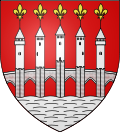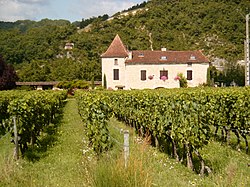Cahors
Cahors (Occitan: [Caors] Error: {{Lang}}: text has italic markup (help)) is a commune in southwestern France. It is in Occitanie. Cahors is the prefecture (capital) of the Lot department. It is also the capital of 3 cantons: Cahors-1, Cahors-2 and Cahors-3.
|
Cahors | ||

| ||
| Valentré bridge | ||
|

| |
| Administration | ||
|---|---|---|
| Country | France | |
| Region | Midi-Pyrénées | |
| Department | Lot | |
| Arrondissement | Cahors | |
| Canton | Cahors-1 Cahors-2 Cahors-3 | |
| Intercommunality | Le Grand Cahors | |
| Mayor | Jean-Marc Vayssouze-Faure[1] | |
| Statistics | ||
| Elevation | 105–332 m (344–1,089 ft) (avg. 122 m (400 ft)*) | |
| Land area1 | 72.48 km2 (27.98 sq mi) | |
| Population2 | 19,630 (2014) | |
| - Density | 271/km2 (700/sq mi) | |
| INSEE/Postal code | 46042/ 46000 | |
| Website | www.mairie-cahors.fr | |
| 1 French Land Register data, which excludes lakes, ponds, glaciers > 1 km² (0.386 sq mi or 247 acres) and river estuaries. | ||
| 2 Population without double counting: residents of multiple communes (e.g., students and military personnel) only counted once. | ||
Cahors was the capital of the old province of Quercy and the people of this city are known, in French, as cadurciens (women: cadurciennes). This name comes from the old name of the city, Carduca.[2]
History
Cahors is an ancient town. The people that inhabited the area at the time of the Roman conquest were called Carduci and so the Romans named the town as Divona or Divona Cadurcorum, "Divona of the Cadurci"; Divona was a source of water, now called "fontaine des Chartreux". The word Cahors comes from Cadurcorum.
Geography
Cahors is located in the southwest of France, in the old province of Quercy, in the valley of the Lot river, and is found in a peninsula (French: [presqu'île] Error: {{Lang}}: text has italic markup (help)) formed by an U-shaped meander of that river which gives its name to the department.
It has an area of 72.48 km2 (27.98 sq mi) and its average altitude is 219 m (719 ft); at the city hall, the altitude is 122 m (400 ft).[3]

|
The commune is at 115 km (71 mi) north of Toulouse and is surrounded by the communes Mercuès, Calamane, Pradines, Arcambal, Lamagdelaine, Laroque-des-Arcs, Trespoux-Rassiels, Labastide-Marnhac, Le Montat and Flaujac-Poujols.
Climate
The climate of Cahors, in the Köppen climate classification, is Cfb - Oceanic climate with temperate summers.
Population
With a population of 19,630,[4] Cahors has a population density of 271 inhabitants/km2.
Evolution of the population in Cahors

Cahors forms, together with the commune Pradines, the urban area of Cahors, with a population of 23,090 inhabitants (2013) and an area of 81.2 km2 (31.4 sq mi).[5] This urban area is the centre of the metropolitan area of Cahors, formed by 44 communes with a population of 44,255 inhabitants (2013) and an area of 712.9 km2 (275.3 sq mi).[6]
Administration
Cahors is the prefecture of the Lot department, the capital of the arrondissement of Cahors and the administrative centre (French: [chef-lieu] Error: {{Lang}}: text has italic markup (help)) of the Cahors-1, Cahors-2 and Cahors-3 cantons.
It is part of the intercommunality Le Grand Cahors (French: [Communauté d'agglomération du Grand Cahors] Error: {{Lang}}: text has italic markup (help)).
Places of interest
Some places of interest are:
- Pont Valentré (Valentré Bridge, Occitan: [Pont de Balandras] Error: {{Lang}}: text has italic markup (help)), a symbol of the town across the Lot river. It was built between 1308 and 1378.[7]
- Cathédrale Saint-Étienne de Cahors (Cahors Cathedral), a national monument in France.
- Arc de Diane (Diane's Arch), remains of Roman baths.
- Saint-Barthélémy Church (14th century).
- Maison Henri IV or Hôtel de Roaldès (15th century).
Gallery
Cahors Media
A Cahors château and vineyard
References
- ↑ "Le Maire de Cahors" (in français). Ville de Cahors. Archived from the original on 4 April 2017. Retrieved 27 February 2017.
- ↑ "Cahors" (in français). habitants.fr. Retrieved 18 May 2014.
- ↑ "Cahors". Map-France.com. Retrieved 19 May 2014.
- ↑ "Régions, départements, arrondissements, cantons et communes" (PDF). Populations légales 2014 (in français). Institut national de la statistique et des études économiques - INSEE. Retrieved 27 February 2017.
- ↑ "Unité urbaine de Cahors (46401)". Comparateur de territoire (in français). Institut national de la statistique et des études économiques - INSEE. Retrieved 27 February 2017.
- ↑ "Aire urbaine de Cahors (162)". Comparateur de territoire (in français). Institut national de la statistique et des études économiques - INSEE. Retrieved 27 February 2017.
- ↑ "Valentré Bridge (Cahors, 1350)" (in français). Structurae - International Database for Civil and Structural Engineering. Retrieved 18 May 2014.
Related pages
Other websites
| Wikimedia Commons has media related to Lua error in Module:Commons_link at line 62: attempt to index field 'wikibase' (a nil value).. |
| Wikivoyage has a travel guide about: Cahors |
- Ville de Cahors - Official website (in French)
- Office de Tourisme de Grand Cahors Archived 2020-12-18 at the Wayback Machine (in English: Grand Cahors Tourist Office Archived 2014-06-08 at the Wayback Machine) (in French)












